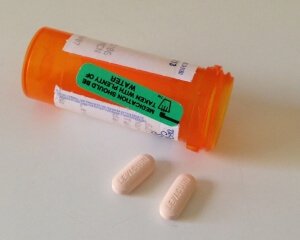Antibiotics, Carbs and Gut Infections | Digestive Health InstituteDigestive Health Institute

A new study by researchers at Stanford University School of Medicine published in the September 2013 issue of Nature proposes a mechanism for how disease–causing microbes such as Salmonella and C diff often thrive when people take antibiotics. Soon after someone takes
antibiotics two things happen: The number of friendly gut bacteria is
dramatically reduced and the amount of available carbohydrates in the
gut is dramatically increased. According to the authors, the extra carbs
and fewer friendly gut bacteria allows the bad bacteria to take over.
It turns out that friendly gut microbes are able to cleave sugars
including fucose and sialic acid from mucus (mucus is made of a variety
of sugars) that cover the entire surface of the gut. With the help of
other friendly microbes these sugars are normally broken down and
shared. But when people take antibiotics many of the bacteria that
cooperate to break down and consume these sugars are lost and bad
bacteria (pathogens) can then use these sugars themselves to grow and
become established.
I found this paper interesting because it lends support to the idea
that fewer excess carbs in the gut leads to more competition which
favors indigenous gut microbes over bad or pathogenic bacteria.
A good example in the paper likens friendly gut microbes to your lawn. “It is
thought that our commensal, or friendly, bacteria serve as a kind of
lawn that, in commandeering the rich fertilizer (carbs) that courses
through our gut, out-competes the less-well-behaved pathogenic “weeds.”
The more healthy grass you have, the fewer weeds will be able to become
established.” But if you were to spray your lawn with roundup (like
antibiotics) and continue to add fertilizer, soon you will have a
weed-filled yard. According to the authors: “Resident microbes hold
pathogens at bay by competing for nutrients.”
While we may not be able to control the amount of sugar chains
comprising our gut mucous supply, there are two things we can do: 1.
Take antibiotics only when they are absolutely necessary. 2. Limit the
overall amount of difficult-to-digest but fermentable carbohydrates in
our diet. That’s the strategy of the Fast Tract Digestion book series
for control of SIBO-related conditions such as IBS, GERD, Rosacea and
many others. One day, this diet strategy may prove to be supportive of
people who need to take an antibiotic. Clearly excess fermentable carbs
is not something you want when you are about to drastically inhibit a
large number of your friendly gut microbes – which is what happens when
you take antibiotics.
Update: Here is an interesting report on how another bad bug,
enterohaemorrhagic Escherichia coli (EHEC), uses a
chemical sensing system to manipulate a friendly gut microbe
(Bacteroides thetaiotaomicron, also the subject of this blog) to serve
it up a nice meal of fucose sugar.

A new study by researchers at Stanford University School of Medicine published in the September 2013 issue of Nature proposes a mechanism for how disease–causing microbes such as Salmonella and C diff often thrive when people take antibiotics. Soon after someone takes
antibiotics two things happen: The number of friendly gut bacteria is
dramatically reduced and the amount of available carbohydrates in the
gut is dramatically increased. According to the authors, the extra carbs
and fewer friendly gut bacteria allows the bad bacteria to take over.
It turns out that friendly gut microbes are able to cleave sugars
including fucose and sialic acid from mucus (mucus is made of a variety
of sugars) that cover the entire surface of the gut. With the help of
other friendly microbes these sugars are normally broken down and
shared. But when people take antibiotics many of the bacteria that
cooperate to break down and consume these sugars are lost and bad
bacteria (pathogens) can then use these sugars themselves to grow and
become established.
I found this paper interesting because it lends support to the idea
that fewer excess carbs in the gut leads to more competition which
favors indigenous gut microbes over bad or pathogenic bacteria.
A good example in the paper likens friendly gut microbes to your lawn. “It is
thought that our commensal, or friendly, bacteria serve as a kind of
lawn that, in commandeering the rich fertilizer (carbs) that courses
through our gut, out-competes the less-well-behaved pathogenic “weeds.”
The more healthy grass you have, the fewer weeds will be able to become
established.” But if you were to spray your lawn with roundup (like
antibiotics) and continue to add fertilizer, soon you will have a
weed-filled yard. According to the authors: “Resident microbes hold
pathogens at bay by competing for nutrients.”
While we may not be able to control the amount of sugar chains
comprising our gut mucous supply, there are two things we can do: 1.
Take antibiotics only when they are absolutely necessary. 2. Limit the
overall amount of difficult-to-digest but fermentable carbohydrates in
our diet. That’s the strategy of the Fast Tract Digestion book series
for control of SIBO-related conditions such as IBS, GERD, Rosacea and
many others. One day, this diet strategy may prove to be supportive of
people who need to take an antibiotic. Clearly excess fermentable carbs
is not something you want when you are about to drastically inhibit a
large number of your friendly gut microbes – which is what happens when
you take antibiotics.
Update: Here is an interesting report on how another bad bug,
enterohaemorrhagic Escherichia coli (EHEC), uses a
chemical sensing system to manipulate a friendly gut microbe
(Bacteroides thetaiotaomicron, also the subject of this blog) to serve
it up a nice meal of fucose sugar.